It takes place in the provinces of Morropón, Ayabaca, Huancabamba in Alto Piura. At the end of the Formative or Early Horizon, the Vicús Culture developed in the northern coastal area of Peru, in the lower course of the Piura River, 7 km from the district of Chulucanas, in the province of Morropón, department of Piura. Its administrative headquarters was on the Vicús hill, at an altitude of 170 meters above sea level; It served as a link with other Andean cities located further north. It covered the provinces of Ayabaca and Huancabamba, Sechura and Talara. Its discoverer was the archaeologist Ramiro Matos – Federico Kauffman Doig (1963).
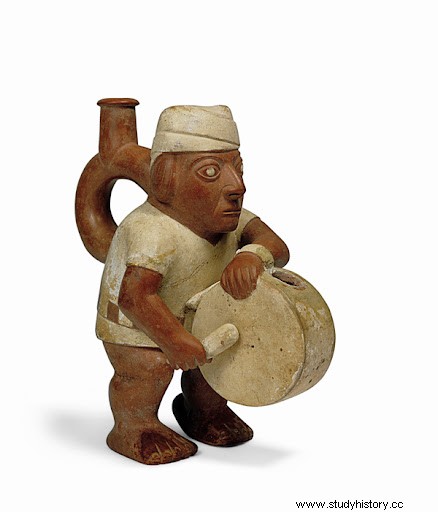
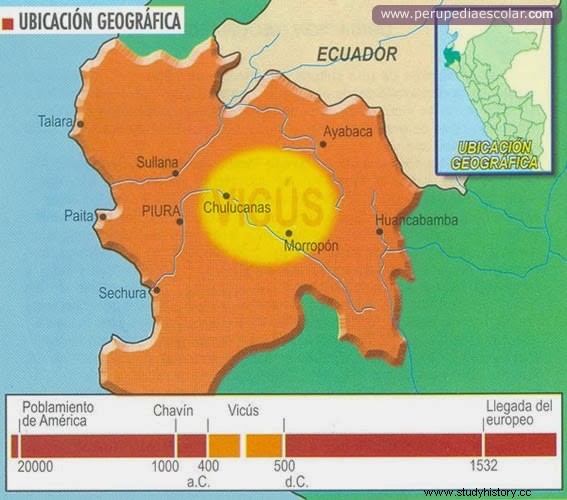
HISTORICAL DEVELOPMENT: The origins of Vicús would be in cultures such as Chorrera, with whom it shares various aspects of the pottery tradition (technique, form and decoration). Approximately in 200 BC, Vicús receives influences from other contemporary and close groups, such as Virú and Moche. This relationship has been interpreted as the arrival of individuals from elites who would have connected with the elites of Vicús, but who would later have come into conflict, causing the collapse of local society.Vicús went through three stages in its development: A.- Stage with influence of Chavín:Initial Period B.- Stage of regional development:Independent Period C.- Stage of Mochica influence:Final Period
 Vicus development timeline POLITICAL AND SOCIAL ORGANIZATION: He managed an ironclad militarism. A strong contingent of noble warriors roamed their domains to enforce the sovereign's mandates and exercise control of society for the use of the workforce. It is known that Vicús was an eminently macho society, where men were the only ones who could wear jewelry and elegant clothes, while noblewomen could only wear very simple suits. It had a militaristic theocratic state where priests fulfilled religious functions protected by a powerful warrior class.
Vicus development timeline POLITICAL AND SOCIAL ORGANIZATION: He managed an ironclad militarism. A strong contingent of noble warriors roamed their domains to enforce the sovereign's mandates and exercise control of society for the use of the workforce. It is known that Vicús was an eminently macho society, where men were the only ones who could wear jewelry and elegant clothes, while noblewomen could only wear very simple suits. It had a militaristic theocratic state where priests fulfilled religious functions protected by a powerful warrior class.  The tombs in the first place and the representations of characters in the clay pieces allow us to suppose that a society existed in Vicús stratified. There were nobles linked to the government, soldiers, merchants, farmers and slaves. José Casafranca in the report he presented, refers to Tomb 11 in which he found more than a hundred objects. The most interesting thing was a crown which suggests that the deceased was a curaca. Other objects also suggested the high class of the deceased as there were many pieces of gold, silver and copper inlaid with turquoise. Knives, masks, sequined belts, glasses, necklaces, and earrings for ears, lips and nose. The soldiers were without a doubt, as in all ancient societies, those who occupied the second place. The huacos represent them with special bonnets that look like crowns, large earmuffs like the noble Inca orejones, with a defensive weapon that was the shield and the baton as an attack weapon. The existence of the merchants is given by the relations that the north had with the peoples of the south of Ecuador, and also by the contacts with the cultures that developed in Lambayeque and Trujillo. Merchants also allowed marine products to reach Vicús, presumably to be consumed by the wealthy classes. Agriculture had to occupy a large number of settlers. Women also participated in these tasks. The slaves were undoubtedly the losers in the struggles between tribe and tribe who had not been sacrificed. Numerous huacos have been found that represent men squatting with their hands tied behind their backs and a rope around their necks. Some of these holes have been found on the guano islands off the Piuran coast and suggest that the prisoners were taken to those places to perform forced labor in the excavation of guano, a task that was not pleasant for others.
The tombs in the first place and the representations of characters in the clay pieces allow us to suppose that a society existed in Vicús stratified. There were nobles linked to the government, soldiers, merchants, farmers and slaves. José Casafranca in the report he presented, refers to Tomb 11 in which he found more than a hundred objects. The most interesting thing was a crown which suggests that the deceased was a curaca. Other objects also suggested the high class of the deceased as there were many pieces of gold, silver and copper inlaid with turquoise. Knives, masks, sequined belts, glasses, necklaces, and earrings for ears, lips and nose. The soldiers were without a doubt, as in all ancient societies, those who occupied the second place. The huacos represent them with special bonnets that look like crowns, large earmuffs like the noble Inca orejones, with a defensive weapon that was the shield and the baton as an attack weapon. The existence of the merchants is given by the relations that the north had with the peoples of the south of Ecuador, and also by the contacts with the cultures that developed in Lambayeque and Trujillo. Merchants also allowed marine products to reach Vicús, presumably to be consumed by the wealthy classes. Agriculture had to occupy a large number of settlers. Women also participated in these tasks. The slaves were undoubtedly the losers in the struggles between tribe and tribe who had not been sacrificed. Numerous huacos have been found that represent men squatting with their hands tied behind their backs and a rope around their necks. Some of these holes have been found on the guano islands off the Piuran coast and suggest that the prisoners were taken to those places to perform forced labor in the excavation of guano, a task that was not pleasant for others.ECONOMY:
 They grew pumpkins, gourds, corn and some fruits, as can be derived from the decoration of their pottery. The main economic activity, like all sedentary people, was agriculture. Due to the timing of the rains and because the rivers dried up after the first months of the year, the men of Vicús built complex hydraulic systems based on rainwater collectors and canals to irrigate the fields. Agriculture was complemented with livestock, hunting and gathering of birds and fauna, both from the interior and from the coast. In the rocks of the latter, they obtained guano to use as fertilizer. As in the rest of Peru, there was the guinea pig, a native duck, and deer and peccary meat was also consumed.
They grew pumpkins, gourds, corn and some fruits, as can be derived from the decoration of their pottery. The main economic activity, like all sedentary people, was agriculture. Due to the timing of the rains and because the rivers dried up after the first months of the year, the men of Vicús built complex hydraulic systems based on rainwater collectors and canals to irrigate the fields. Agriculture was complemented with livestock, hunting and gathering of birds and fauna, both from the interior and from the coast. In the rocks of the latter, they obtained guano to use as fertilizer. As in the rest of Peru, there was the guinea pig, a native duck, and deer and peccary meat was also consumed. CULTURAL EXPRESSIONS:
CERAMIC: Morphologically, Vicús pottery has been separated into three types:
- Vicus negative: It comprises simple circles, scrolls, and triangles that appear in containers with figures of animals. In the Vicús Negative pottery we can see warriors, musicians, and erotic scenes with nude figures of both sexes.
- Vicus white on red: it is similar to Vicús Negativo, since it presents anthropomorphic, phytomorphic and zoomorphic sculptural containers. Its decoration combines white, applications, incisions and lines.
- Monochrome slipped Vicús: It has a rough appearance, with dark spots due to cooking defects. It features bell-bottomed vessels, tripods, or pedestals.
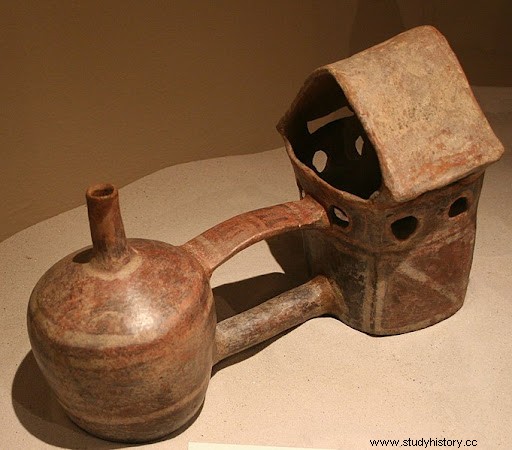
Characteristics of its pottery:
- Shape: double body containers and pitchers.
- Stirrup neck handle
- Polychrome color (brown, white, yellow, orange and red)
- Technique: negative painting (white on red) It consists of not painting the decorated part, but the surrounding areas to highlight them better.
- Trend: sculptural and realistic.
- Feature object: Huacos or whistling bottles that give sounds similar to that of animals:snake, monkey, bird, etc.
- Anthropomorphic, zoomorphic and feline figures dominate.

METALLURGY AND GOLDWORK:
They knew the Champi or the Tumbaga (alloy of gold with silver). They worked with gold, silver and copper. They made embossed sheets, carved vessels, laminated gold masks, necklaces, bracelets and gold nose rings, etc. adorned with anthropomorphic, zoomorphic, geometric and hybrid motifs. A clear example is:The Venus of Frías. If the best ceramic pieces have been extracted in Vicús, it has been in Frías instead where the best objects worked in metal have been extracted. Gold, silver and copper were worked using the hammering, embossing and molding system. When making the jewelry they used pearl shells brought from Sechura and not infrequently pearls and emeralds, or turquoise. The use of copper plates combined with gold was very frequent. This is how small gold disks have been found in Frías, to which other smaller copper ones were welded, ornaments that could well have been used as earmuffs. Vases of gold, undoubtedly for ceremonial use, embossed. In the Museo Oros del Perú of the Miguel Mujica Gallo Foundation, there is a 20-carat gold nose ring weighing 9 grams that is shaped like a quarter moon. The piece measures 10 centimeters wide. From the lower edge hang 7 small gold discs and in the center hangs a crab. It seems that in the other part of this piece there were 7 other discs that no longer exist.
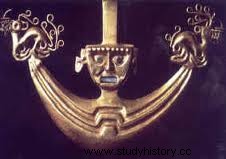
Many of these articles were adorned with anthropomorphic, zoomorphic, geometric and hybrid motifs.- They worked the gold, silver, copper and their alloys.- Making ornaments such as protectors, necklaces, masks, bracelets, earmuffs and others. Technique:lamination, hammering, gilding.
VENUS DE FRÍAS:
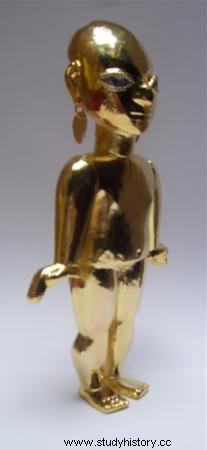 Also called the Venus of Frías, it represents a nude woman worked in embossed gold, hammered and welded in halves. Some movement is noted for her head and for her hands. It seems that her hands rested on some object in which case the statuette was part of a set. The statuette's features are remarkably feminine despite her broad shoulders and narrow hips. Two rings hang from her ears and her eyes are enormous. For the archaeologist Lumbreras, the Frías statuette is imported. In the “Arte y la Vida Vicús” he says:“without a doubt it was made in Esmeraldas (Ecuador) or in Tumaco (Colombia) since it belongs to the Tolita style precisely from the time of Regional Developments”. The archaeologist Kauffmann Doig, the It is given as "belonging to the Vicús circle", and only similar to those of Colombia. (Ancient Peru). The figurine has been in the Museo Brunning de Lambayeque for a long time. On November 20, 1956, the curator of the Museum, Mr. Oscar Fernández de Córdova, seized it from some looters who were offering it for sale and took it to the Museum. The statuette, which is all gold, weighs 60 grams and is 153 mm high. It was built with 22 carat gold plated. The Director of the Museum Walter Alva - discoverer of the tomb of the Lord of Sipán - considered it to belong to the Frías style.
Also called the Venus of Frías, it represents a nude woman worked in embossed gold, hammered and welded in halves. Some movement is noted for her head and for her hands. It seems that her hands rested on some object in which case the statuette was part of a set. The statuette's features are remarkably feminine despite her broad shoulders and narrow hips. Two rings hang from her ears and her eyes are enormous. For the archaeologist Lumbreras, the Frías statuette is imported. In the “Arte y la Vida Vicús” he says:“without a doubt it was made in Esmeraldas (Ecuador) or in Tumaco (Colombia) since it belongs to the Tolita style precisely from the time of Regional Developments”. The archaeologist Kauffmann Doig, the It is given as "belonging to the Vicús circle", and only similar to those of Colombia. (Ancient Peru). The figurine has been in the Museo Brunning de Lambayeque for a long time. On November 20, 1956, the curator of the Museum, Mr. Oscar Fernández de Córdova, seized it from some looters who were offering it for sale and took it to the Museum. The statuette, which is all gold, weighs 60 grams and is 153 mm high. It was built with 22 carat gold plated. The Director of the Museum Walter Alva - discoverer of the tomb of the Lord of Sipán - considered it to belong to the Frías style. GRAVES: Close to Cerro Vicús, nearly two thousand funerary wells have been found, true mortuary chimneys with an antiquity of twelve to fourteen centuries. One of the characteristics of Vicús is precisely these tombs, which were excavated at a great depth, between 4 and 11 meters, but there are some of 15 meters. The most frequent consist of vertical tubular wells that lead to the chamber, arranged to one side. It is because of this characteristic that they are called "boot" tombs. In the tombs of the Vicús cemeteries, there is not a corpse in the place that anyone can suppose. What they find are elongated forms reduced to dust, about 60 centimeters long and 12 or 10 cm thick. It is assumed that the corpses were cremated and the ashes wrapped in cloth, deposited in the tombs, because pieces of cloth have been found. Possibly the deepest graves belong to people of more importance. They are also the ones that contain the largest number of ceramic and metal pieces. The offerings consisted of ceramic, metal, and semi-precious stones such as lapis lazuli and turquoise.
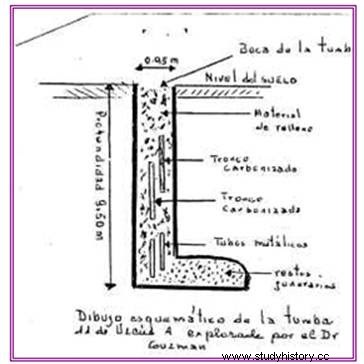 RELIGION :For many ancient peoples of the Peruvian coast, their Gods always came out of the sea and some returned to it. They were always powerful characters full of great majesty. The infinity of the sea, which was always lost on the horizon, apparently joining the sky, was a mystery impossible to unravel. That is why the sea for the ancients was a kind of abode of the gods. It was known by the name of mama-cocha or mother-sea, in the Inca empire. They worshiped the moon, the earth and the stars. They were polytheists.
RELIGION :For many ancient peoples of the Peruvian coast, their Gods always came out of the sea and some returned to it. They were always powerful characters full of great majesty. The infinity of the sea, which was always lost on the horizon, apparently joining the sky, was a mystery impossible to unravel. That is why the sea for the ancients was a kind of abode of the gods. It was known by the name of mama-cocha or mother-sea, in the Inca empire. They worshiped the moon, the earth and the stars. They were polytheists. VICÚS CULTURE BURIALS: Music played an important role in the ritual life of the Vicús. It was expressed in different areas of their culture and, very especially, in their funeral rites. A significant number of instruments have been found in the mortuary trousseau, such as ceramic drums, flutes or whistle bottles. On ceramics, musicians playing antaras are one of the most common representations, often appearing in themes that allude to funerary rituals. The tombs were tubular and many were boot-shaped, with a chamber in the deepest part. There they deposited the bodies accompanied by trousseaus of different richness according to the hierarchy of the deceased, who, apparently, in many cases was cremated.
ARCHITECTURE: The sacred hill of Vicus is a monumental and ceremonial complex destined for worship, and hence its character as a sacred hill. The Complex comprises:a) A system of terraces, and b) A ceremonial sanctuary.
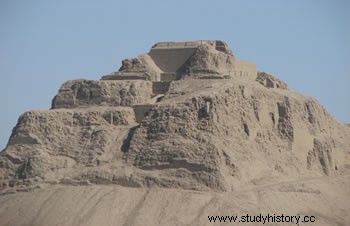
The terraces found in the first phase of the investigation are 4 that in total add up to 80 meters of length. They are superimposed taking advantage of the slopes of the hill. Two of them, the highest, are 40 meters long, 17 m. wide and 3.50 m. Tall. Some are located crosswise and others longitudinally, more or less 180 meters high.
THE END OF THE VICÙS: If the origin of the Vicús is uncertain, even more mysterious is how they disappeared. The majority of historians consider that the Vicús appear in the year 500 BC and disappear after the year 900 AD. For the archaeologist Lumbreras, the Vicús appear around 500 B.C. in the Early Formative Epoch and disappear 500 AD. One hypothesis that is mentioned as the cause of the destruction of the Vicús would be the exceptionally strong El Niño phenomenon, with intense rains as occurs in that region, which forced the population to disperse.
"The Vicus Potters" «The Vicus potters handled their pottery in up to 68 different ways. Such was the mastery over their materials that these artists had that they managed to perfect the sound corresponding to the animal they represented. In Vicus ceramics, the animal representation predominates over the human figure, it is common among its characters to design the eyes in a special way that some archaeologists call "coffee beans". Among the characters represented by the Vicus artists there is a divinity with feline features that is part of the family in which there are numerous relatives such as the Raimondi stone (Chavín), the Mochica God or the Cover of the Sun (Tiahuanaco). There is also a mythological character that seems to be linked more to the feline with the Vampire, a religious and artistic theme, not only Andean bread, but also American bread... “History of Peru 1” Pablo Macera -VICUS
